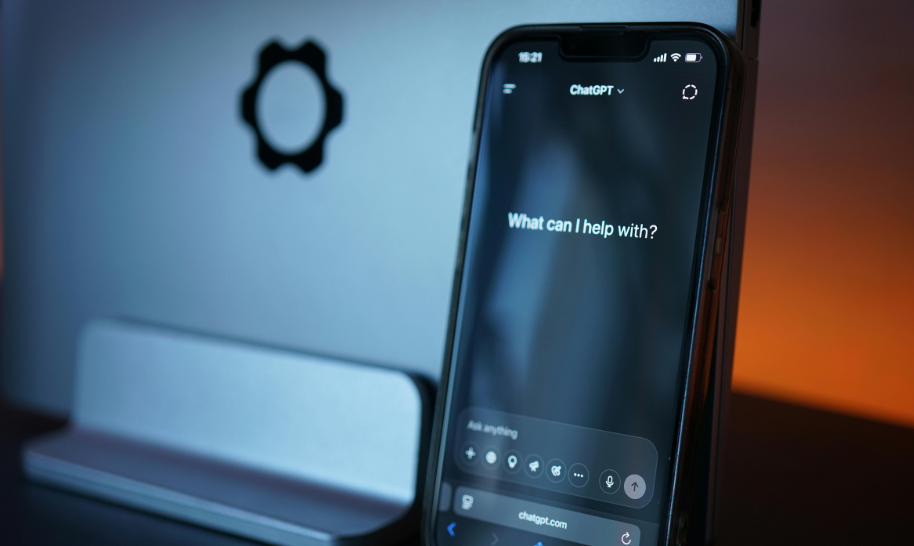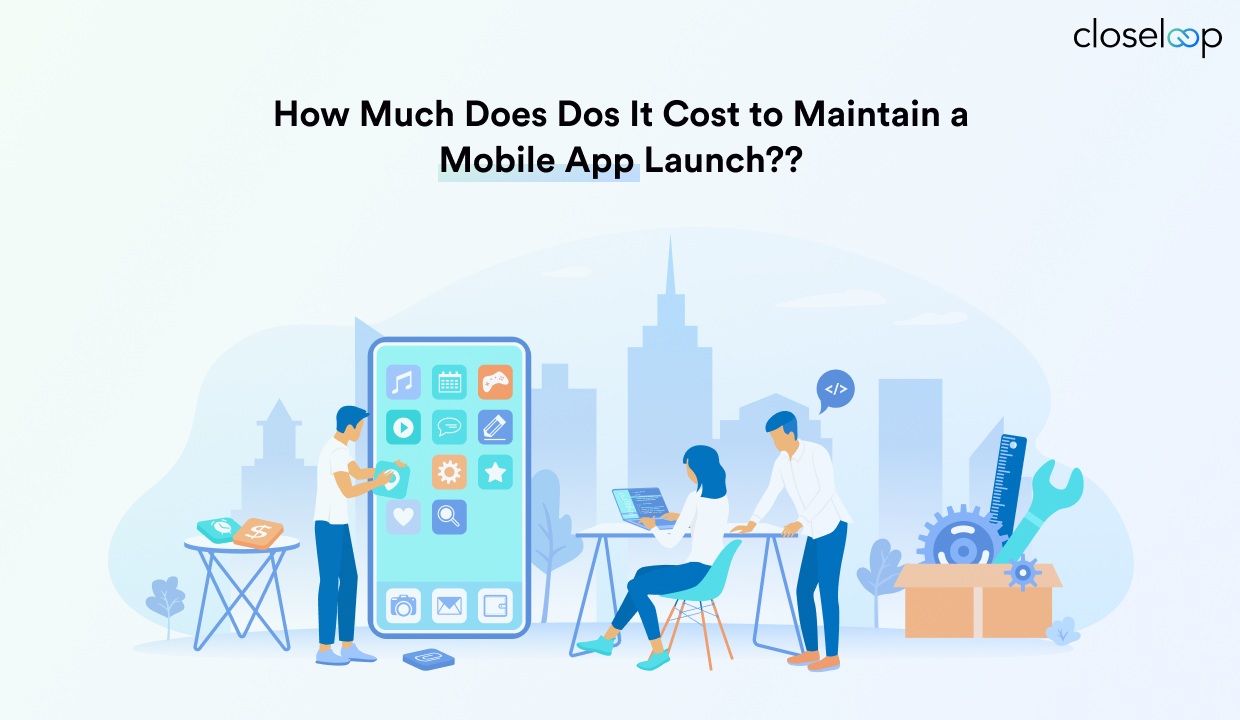
Launching a mobile app marks an exciting milestone, but it's merely the first step in a much longer journey. The harsh reality of today's app ecosystem reveals that development costs are just the beginning—ongoing maintenance represents a significant and unavoidable investment that directly impacts your app's survival and success. Recent industry data paints a stark picture of neglect consequences.
According to the Pixalate Report, Google Play and App Store removed over 1.5 million applications in the past year, with 78% classified as "abandoned" due to lack of updates beyond 24 months. This represents a 15% increase from previous years, highlighting the increasingly competitive landscape where only actively maintained apps thrive. |
The financial commitment for post-launch maintenance typically ranges from 15-25% of your initial development investment annually. For a $100,000 app, expect $15,000-$25,000 yearly in maintenance costs. However, this investment proves essential—as apps that often fail to retain users in the first week end up losing 80% of them, and this is a steep price for any organization.
At Closeloop, we've witnessed firsthand how strategic maintenance transforms good apps into market leaders. The question isn't whether you can afford to maintain your app, but whether you can afford not to. Understanding these costs upfront enables better budget planning and ensures your digital product remains competitive, secure, and user-friendly in an ever-evolving mobile landscape.
Key Takeaways
Industry Standard Costs: Mobile app maintenance typically requires 15-25% of your original development budget annually, translating to $15,000-$25,000 yearly for a $100,000 app
Critical Cost Factors: App complexity, platform coverage, user base size, third-party integrations, and security requirements significantly impact your maintenance budget requirements
Hidden Expenses: Geographic location of development teams, regulatory compliance, technology stack age, and seasonal maintenance demands often create unexpected budget pressures
Strategic Budget Planning: Revenue-based investment strategies, risk-adjusted priorities, and industry-specific considerations help optimize maintenance spending for maximum ROI
Business Impact Analysis: Well-maintained apps achieve 40-60% higher user retention rates and generate 3-5x lifetime revenues compared to neglected applications
Investment Justification: Maintenance prevents the 78% app abandonment rate that leads to app store removal and protects against user loss exceeding 80% in the first week
Professional Partnership Benefits: Working with experienced providers like Closeloop transforms maintenance from operational overhead into strategic growth investment
Practical Implementation: Phased investment approaches, quarterly budget reviews, and performance-based frameworks ensure maintenance spending aligns with business objectives and market conditions
What is the Mobile App Maintenance Cost: A General Overview
Mobile app maintenance costs follow a predictable pattern that every business owner should understand before diving into app development. The industry standard sits at 15-25% of your original development budget annually, but this percentage tells only part of the story.
Think of app maintenance like owning a car—you wouldn't expect to buy a vehicle and never change the oil, replace tires, or address mechanical issues. Your app requires similar ongoing attention to perform optimally and remain competitive.
The actual dollar amounts vary dramatically based on your app's complexity and market positioning. A simple utility app might cost $5,000-$15,000 annually to maintain, while an enterprise-level application with advanced features could require $50,000-$150,000 yearly. These figures aren't arbitrary—they reflect the real-world resources needed for security updates, platform compatibility, bug fixes, and feature enhancements.
Annual Maintenance Cost Breakdown by App Category:
App Type | Development Cost | Annual Maintenance (15-25%) | Key Maintenance Focus |
Simple Utility | $20,000-$50,000 | $3,000-$12,500 | Bug fixes, OS updates |
E-commerce | $50,000-$150,000 | $7,500-$37,500 | Security, payment integration |
Social Media | $100,000-$300,000 | $15,000-$75,000 | Server scaling, new features |
Enterprise | $200,000-$500,000 | $30,000-$125,000 | Compliance, integrations |
Gaming | $150,000-$1,000,000 | $22,500-$250,000 | Content updates, performance |
What makes these costs unavoidable is the dynamic nature of mobile technology. Operating systems update frequently, security threats evolve constantly, and user expectations grow continuously. Your maintenance budget essentially buys you relevance—without it, your app becomes obsolete regardless of how brilliant your initial concept was.
ALSO READ: How Much Does It Cost to Build a Mobile App in 2025?
Factors Affecting the Cost of Mobile App Maintenance After Launch
Understanding what drives maintenance costs helps you budget effectively and make informed decisions about your app's future. Several key factors directly impact your annual maintenance investment, each contributing differently based on your specific circumstances.
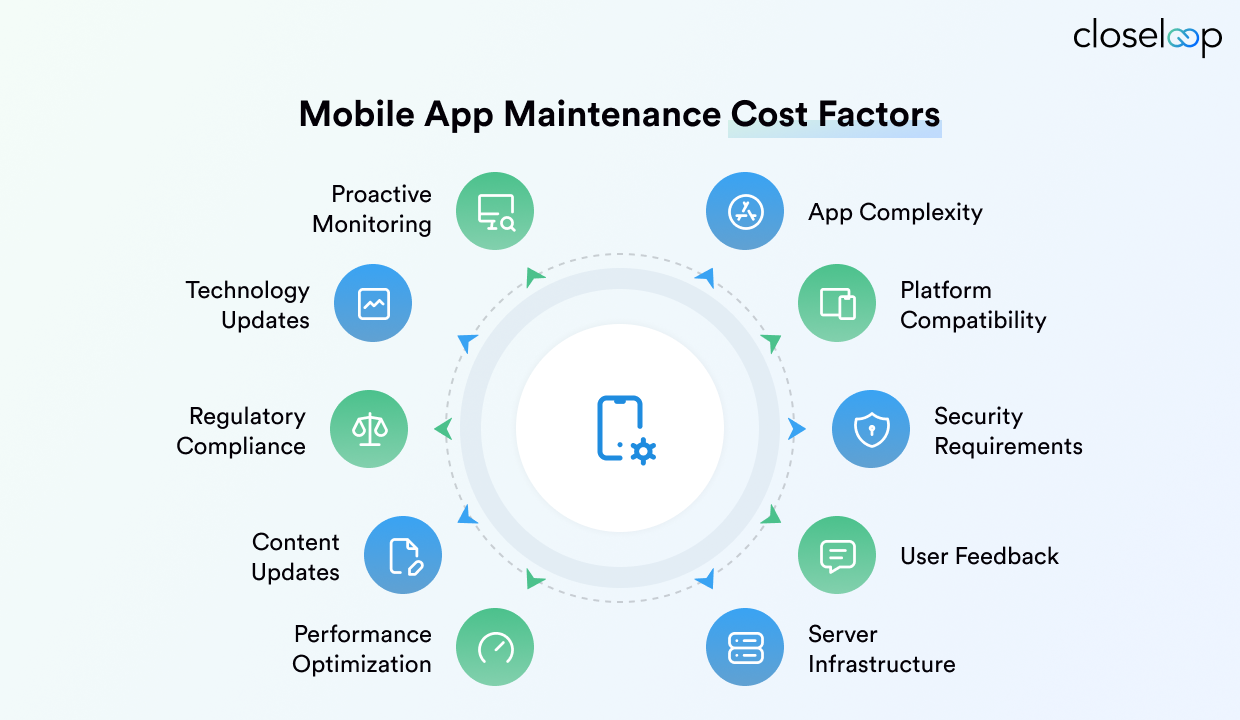
App Complexity and Features
Complex apps with multiple integrated features demand significantly more maintenance resources than simple, single-purpose applications. Every additional feature introduces potential failure points, requires individual updates, and needs ongoing optimization. Apps with advanced functionalities like AI integration, real-time messaging, or complex databases require specialized expertise and more frequent attention.
Maintenance Cost by App Complexity:
Complexity Level | Features | Annual Cost Range | Maintenance Hours/Month |
Simple | Basic UI, minimal features | $3,000-$8,000 | 10-25 hours |
Moderate | User accounts, basic integrations | $8,000-$25,000 | 25-60 hours |
Complex | Multiple integrations, advanced features | $25,000-$60,000 | 60-150 hours |
Enterprise | AI/ML, real-time processing, extensive APIs | $60,000-$200,000+ | 150-400+ hours |
Platform Coverage
Supporting multiple platforms multiplies your maintenance workload exponentially. Each platform—iOS app development, Android app development, web, or desktop—requires separate updates, testing cycles, and optimization efforts. Cross-platform solutions can reduce some overhead, but platform-specific features and guidelines still demand individual attention.
Platform Maintenance Cost Breakdown:
Platform Strategy | Platforms Supported | Cost Multiplier | Annual Range |
Single Platform | iOS OR Android | 1x | $5,000-$30,000 |
Dual Mobile | iOS + Android | 1.7x | $8,500-$51,000 |
Multi-Platform | Mobile + Web | 2.3x | $11,500-$69,000 |
Omni-Platform | Mobile + Web + Desktop | 3x | $15,000-$90,000 |
User Base Size and Activity
Larger user bases generate more support requests, require robust server infrastructure, and demand higher performance standards. Apps serving thousands of daily active users face different challenges than those supporting millions. Increased traffic means more potential issues, higher server costs, and greater pressure for rapid problem resolution.
User Base Impact on Maintenance:
Active Users | Support Volume | Infrastructure Needs | Annual Cost Range |
<10,000 | Low support tickets | Basic hosting | $3,000-$15,000 |
10K-100K | Moderate support load | Scalable infrastructure | $15,000-$50,000 |
100K-1M | High support volume | Advanced monitoring | $50,000-$150,000 |
1M+ | Enterprise support needs | Enterprise infrastructure | $150,000-$500,000+ |
Third-Party Integrations
Every third-party service your app connects to introduces maintenance complexity. Payment processors, social media APIs, analytics tools, and cloud services regularly update their protocols, requiring corresponding changes in your app. Integration failures can break core functionality, making this a critical maintenance area.
Integration Maintenance Costs:
Integration Type | Typical Count | Update Frequency | Annual Cost Impact |
Basic (Analytics, Crash reporting) | 2-4 integrations | Quarterly | $2,000-$8,000 |
Standard (Payments, Social, Maps) | 5-10 integrations | Monthly | $8,000-$25,000 |
Advanced (Enterprise APIs, Custom) | 10-20 integrations | Bi-weekly | $25,000-$60,000 |
Enterprise (Multiple vendors) | 20+ integrations | Weekly | $60,000-$150,000+ |
Security Requirements
Apps handling sensitive data—financial information, personal details, or business data—require enhanced security maintenance. Compliance with regulations like GDPR, HIPAA, or PCI-DSS demands regular security audits, vulnerability assessments, and immediate response to emerging threats. The cost of security breaches far exceeds prevention investments.
Security-Based Maintenance Costs:
Security Level | Compliance Needs | Security Features | Annual Cost Range |
Basic | Standard app security | SSL, basic encryption | $2,000-$10,000 |
Enhanced | Industry best practices | Advanced authentication | $10,000-$35,000 |
Regulated | GDPR, HIPAA compliance | Regular audits, monitoring | $35,000-$80,000 |
Enterprise | Multiple regulations | 24/7 security, penetration testing | $80,000-$250,000+ |
ALSO READ: Step to develop a feature-rich mobile app
Other Factors to Consider While Calculating App Maintenance Cost
Beyond the primary cost drivers, several often-overlooked factors can significantly impact your app maintenance budget. Understanding these additional considerations helps create more accurate financial projections and prevents unexpected expenses that could strain your resources.
1. Geographic Location of Development Team
The location of your maintenance team dramatically affects costs, with hourly rates varying by up to 500% globally. North American developers typically charge $100-$200 per hour for maintenance work, while Eastern European teams range from $30-$80 hourly. Asian development centers often provide services at $20-$60 per hour, though time zone differences may impact response times for critical issues.
However, geographic cost differences extend beyond hourly rates. Local market conditions, currency fluctuations, and regional expertise availability all influence total maintenance costs. Teams in emerging markets may offer lower rates but require more hours to complete complex tasks, potentially negating initial savings. Additionally, communication barriers and cultural differences can increase project management overhead.
2. Maintenance Team Structure and Expertise
The composition of your maintenance team significantly impacts both costs and effectiveness. In-house teams provide maximum control and deep product knowledge but require full-time salaries, benefits, and overhead costs. A dedicated in-house maintenance developer costs $80,000-$150,000 annually in most markets, plus additional expenses for tools, training, and management.
Outsourced maintenance offers flexibility and cost control but may lack intimate product knowledge. Freelance specialists charge project-based fees ranging from $5,000-$50,000 annually depending on app complexity. Hybrid approaches combining in-house oversight with external specialists often provide optimal balance between cost and quality.
ALSO READ: Freelancers vs Mobile App Development Agencies
3. Regulatory Compliance and Industry Standards
Apps serving regulated industries face unique maintenance requirements that substantially increase costs. Healthcare applications must maintain HIPAA compliance, requiring regular security audits, staff training, and documentation updates. Financial apps need PCI-DSS certification maintenance, involving quarterly vulnerability scans and annual assessments.
Compliance maintenance extends beyond initial certification. Regulatory changes require immediate updates to maintain legal operation. For example, GDPR modifications in 2024 forced thousands of apps to update privacy policies, data handling procedures, and user consent mechanisms within 90-day windows. Non-compliance penalties often exceed entire maintenance budgets, making these updates non-negotiable.
4. Technology Stack Age and Legacy Dependencies
Older technology stacks require more maintenance attention as frameworks reach end-of-life status. Apps built on deprecated technologies face increasing maintenance costs as third-party support diminishes. Legacy database systems, outdated programming languages, and discontinued frameworks create technical debt that compounds over time.
Modern technology stacks typically require 20-30% less maintenance effort than legacy alternatives. However, migrating from legacy systems involves substantial upfront investments. The decision between continuing expensive legacy maintenance versus investing in modernization often determines long-term cost trajectories.
5. Data Storage and Backup Requirements
Growing user bases generate exponentially increasing data storage needs. Apps that initially required minimal database maintenance evolve into data-intensive platforms requiring sophisticated backup strategies, archival systems, and performance optimization. Cloud storage costs scale with usage, often surprising businesses with unexpected monthly charges.
Database maintenance complexity increases with data volume and variety. Simple apps might spend $100-$500 monthly on data services, while data-heavy applications require $5,000-$50,000 in monthly infrastructure costs. Regular database optimization, backup verification, and disaster recovery testing add operational overhead that many budgets overlook.
6. Seasonal and Event-Driven Maintenance Needs
Many apps experience seasonal usage patterns that create concentrated maintenance demands. E-commerce apps require intensive preparation for holiday shopping seasons, including load testing, inventory system updates, and payment processor optimizations. Gaming apps need special event content and promotional campaigns that require dedicated development cycles.
These seasonal spikes often require temporary team scaling or overtime compensation. Black Friday preparation might require 200-300% normal maintenance effort for retail apps. Tax season creates similar demands for financial applications. Budget planning must account for these predictable but concentrated resource needs.
7. Analytics and Monitoring Infrastructure
Comprehensive app monitoring requires sophisticated tooling that adds ongoing costs often underestimated during initial budgeting. Basic crash reporting services cost $100-$500 monthly, while enterprise monitoring solutions range from $1,000-$10,000 monthly depending on user volume and feature requirements.
Advanced analytics platforms provide valuable insights but require integration maintenance, custom dashboard development, and regular data analysis. The cost of monitoring infrastructure often represents 5-10% of total maintenance budgets but provides essential visibility into app performance and user behavior patterns.
8. Legal and Intellectual Property Maintenance
App store policies evolve continuously, requiring legal review and compliance updates. Privacy policy modifications, terms of service updates, and intellectual property protection measures create ongoing legal expenses. International expansion introduces additional complexity with country-specific legal requirements.
Patent landscapes shift regularly in the mobile app space, requiring defensive measures and potential licensing negotiations. Legal maintenance costs typically range from $2,000-$20,000 annually for most apps, but can spike dramatically during policy changes or intellectual property disputes.
9. Version Fragmentation Management
Supporting multiple app versions simultaneously multiplies maintenance complexity. While forcing immediate updates alienates users, supporting too many versions creates unsustainable maintenance burdens. Each supported version requires separate bug fixes, security patches, and testing cycles.
Optimal version support strategies typically maintain 2-3 recent versions while phasing out older releases through user communication and incentive programs. However, enterprise clients often demand extended support for specific versions, creating custom maintenance streams that require dedicated resources and specialized knowledge retention.
Why is Mobile App Support and Maintenance Crucial?
Mobile app maintenance isn't optional—it's the difference between thriving and disappearing in today's competitive digital landscape. The statistics paint a sobering picture: Google Play Store has dropped from approximately 3.4 million apps to around 1.8 million in 2024, a 47% decrease, with the majority removed due to abandonment and lack of maintenance. Understanding why maintenance matters helps justify the investment and shapes your long-term app strategy.
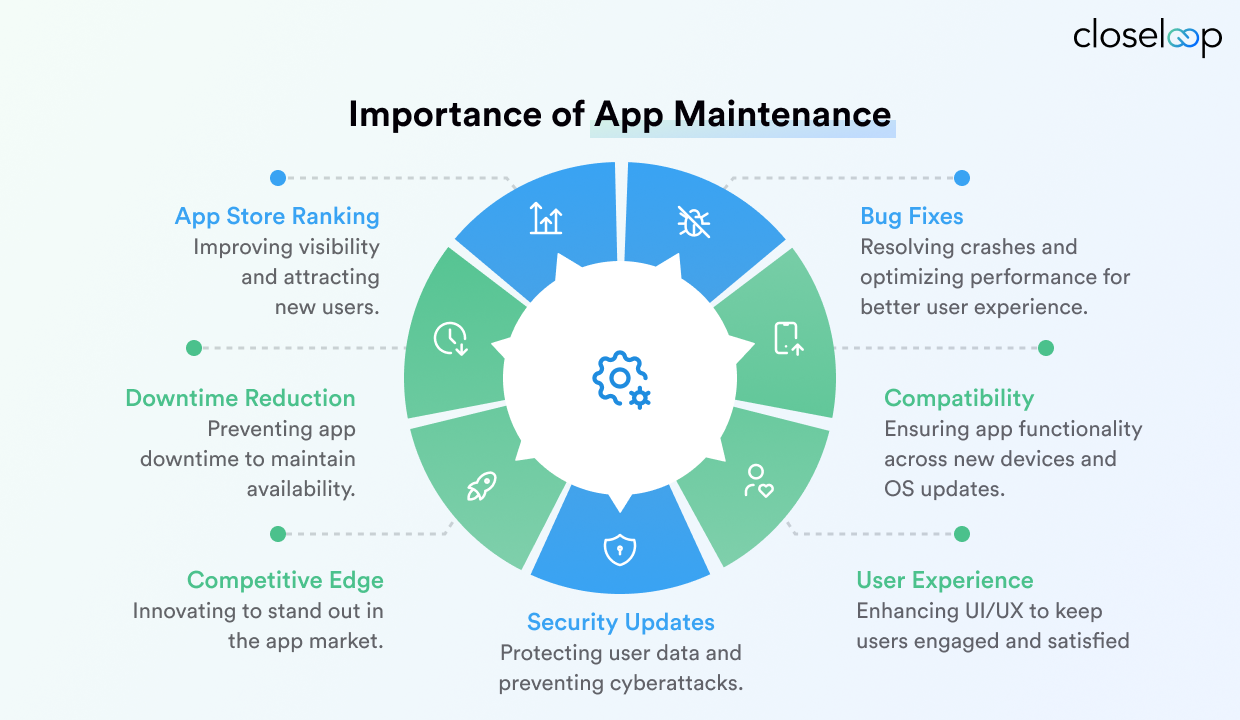
Preventing User Abandonment and Ensuring Retention
User expectations have reached unprecedented heights in 2025. Users expect apps to load in under 3 seconds, and every additional second increases abandonment rates by 32%. More alarmingly, 71% of users abandon apps within 90 days of downloading, with 45% deleting apps after a single crash. These statistics reveal the unforgiving nature of user behavior—there's virtually no tolerance for poor performance.
App performance naturally degrades over time without proper maintenance. Memory leaks accumulate, causing applications to consume excessive RAM and drain battery life. Background processes become inefficient, loading times increase, and user interfaces become sluggish. What once felt smooth and responsive gradually transforms into a frustrating experience that drives users away.
Regular maintenance addresses these performance issues before they impact users. Code optimization, memory management improvements, and performance monitoring ensure your app maintains the speed and responsiveness users demand. Companies that prioritize performance maintenance report 40-60% higher user retention rates compared to those that neglect these critical updates.
Staying Compatible with Evolving Platforms
Operating system updates are inevitable and frequent. Apple releases major iOS updates annually, along with several minor updates throughout the year. Google follows a similar pattern with Android, introducing new features, security enhancements, and interface changes that can break existing functionality if not properly addressed.
Without maintenance, your app becomes increasingly incompatible with newer OS versions. Features stop working, layouts break, and security vulnerabilities emerge. Users running updated systems encounter crashes, frozen screens, and missing functionality. Eventually, app stores may refuse to list applications that haven't been updated to support current platform requirements.
Proactive maintenance ensures seamless compatibility across all supported platforms. This includes testing on new OS versions during beta releases, updating deprecated APIs before they're removed, and adapting to new design guidelines. Apps that maintain platform compatibility consistently rank higher in app store searches and receive better user ratings.
Security and Data Protection Requirements
Cybersecurity threats evolve constantly, with new vulnerabilities discovered regularly. Apps that handle user data—which includes virtually every modern application—become targets for malicious attacks. Data breaches don't just harm users; they destroy business reputations and trigger costly legal consequences.
Security maintenance involves multiple layers of protection. Regular security audits identify potential vulnerabilities before exploitation occurs. SSL certificate renewals ensure encrypted data transmission continues uninterrupted. Authentication systems require updates to address emerging threats, and compliance with regulations like GDPR, CCPA, and industry-specific requirements demands ongoing attention.
The cost of prevention through regular security maintenance pales compared to breach consequences. Data breach costs average $4.88 million globally, not including reputation damage and long-term customer loss.
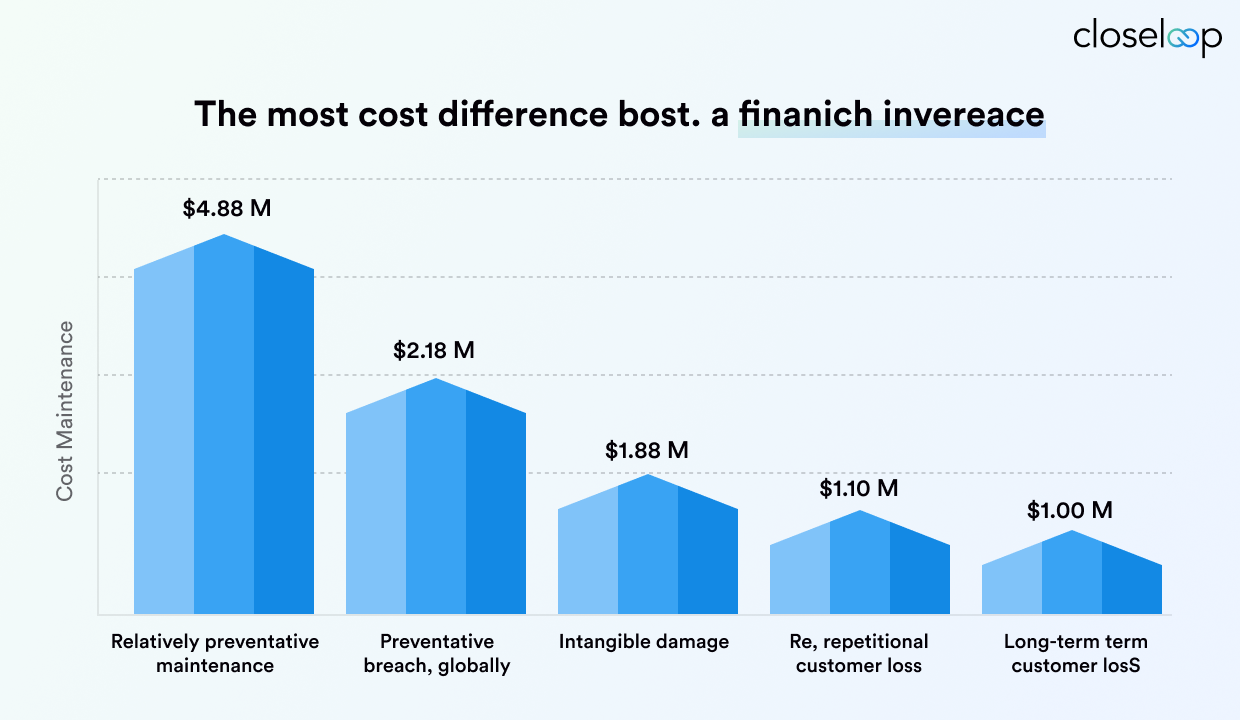
Proactive security maintenance typically costs 10-15% of development budgets but protects against losses that could exceed total project investments.
Maintaining Competitive Advantage
The mobile app ecosystem moves at breakneck speed. Competitor analysis reveals new features, design trends, and user experience innovations emerging monthly. Apps that remain static quickly appear outdated compared to actively evolving alternatives.
Maintenance provides opportunities for continuous improvement beyond basic functionality preservation. User feedback analysis reveals pain points and desired features. Performance analytics highlight usage patterns and optimization opportunities. Regular updates demonstrate active development, building user confidence and encouraging continued engagement.
Market leaders consistently invest in maintenance and enhancement cycles. They introduce new features regularly, refine existing functionality based on user feedback, and adapt to changing market conditions. This continuous evolution keeps them ahead of competitors and maintains user interest over time.
App Store Algorithm Benefits
App store algorithms favor actively maintained applications when determining search rankings and featured placement. Both Google Play and Apple App Store consider update frequency, user ratings, crash rates, and engagement metrics when ranking apps in search results.
Recent updates signal to app stores that applications remain active and well-supported. Higher search rankings lead to increased organic downloads, reducing customer acquisition costs. Featured placements in app stores can drive massive download spikes, significantly expanding user bases without additional marketing investments.
Apps that maintain consistent update schedules often see 25-40% higher organic download rates compared to infrequently updated alternatives. This organic growth compounds over time, creating substantial competitive advantages that justify maintenance investments through improved market positioning.
Long-term Business Viability
Successful apps generate revenue streams that extend far beyond initial launch periods. In-app purchases, subscription models, and advertising revenue create ongoing income potential that depends entirely on maintaining active user bases. Without proper maintenance, these revenue streams quickly deteriorate as users abandon poorly performing applications.
Investment in maintenance protects and grows these revenue opportunities. Well-maintained apps experience higher user lifetime values, increased conversion rates, and stronger customer loyalty. Users are more likely to recommend maintained apps to others, creating valuable word-of-mouth marketing that reduces customer acquisition costs.
The mathematics are compelling: apps with consistent maintenance programs typically generate 3-5x higher lifetime revenues compared to launched-and-abandoned alternatives. This return on maintenance investment often exceeds initial development ROI, making maintenance not just necessary but highly profitable for sustainable business growth.
Strategic Investment Planning: Determining Your Optimal App Maintenance Budget
Setting the right maintenance budget requires balancing financial constraints with business objectives. Industry consensus establishes that app maintenance costs typically range from 15-20% of the total mobile app development cost, but this baseline figure doesn't account for your specific business context, growth trajectory, or competitive positioning.
Budget Allocation Framework by Business Stage
Your maintenance investment should align with your business maturity and revenue expectations. Research indicates that well-maintained apps can generate returns of $74.60 for every dollar spent on production and maintenance over a 7-year lifecycle, making maintenance a strategic investment rather than operational overhead.
Startup and MVP Stage Budgeting:
Budget Category | Percentage of Development Cost | Annual Range | Focus Areas |
Minimal Viable Maintenance | 10-12% | $5,000-$15,000 | Critical bugs, security patches |
Growth-Oriented Maintenance | 15-18% | $15,000-$35,000 | Performance optimization, feature updates |
Competitive Maintenance | 20-25% | $35,000-$60,000 | Market adaptation, advanced features |
ALSO READ: Cost of Building an MVP vs Mobile Application
Established Business Budgeting:
Business Revenue | Recommended Maintenance % | Annual Investment | Expected ROI |
<$500K annual | 12-15% | $10,000-$40,000 | 150-200% |
$500K-$2M annual | 15-20% | $40,000-$100,000 | 200-300% |
$2M-$10M annual | 18-25% | $100,000-$400,000 | 300-500% |
$10M+ annual | 20-30% | $400,000+ | 400-700% |
Revenue-Based Maintenance Investment Strategy
The mobile app market is projected to generate $613 billion in revenue in 2025, highlighting the massive opportunity for well-maintained applications. Your maintenance budget should correlate directly with revenue generation potential and current performance metrics.
Revenue-Driven Budget Allocation:
Current App Revenue | Maintenance Investment | Growth Target | Timeline |
Pre-revenue (MVP) | 10-15% of dev cost | First $10K MRR | 6-12 months |
$1K-$10K MRR | 15-20% of revenue | $25K-$50K MRR | 12-18 months |
$10K-$50K MRR | 20-25% of revenue | $100K+ MRR | 18-24 months |
$50K+ MRR | 25-30% of revenue | Scale optimization | Ongoing |
Risk-Adjusted Investment Planning
Analysis shows that 45% of application features are never used, emphasizing the importance of strategic maintenance investment rather than blanket spending. Your budget should prioritize high-impact areas that directly influence user retention and revenue generation.
Risk-Based Maintenance Priorities:
Risk Level | Budget Allocation | Maintenance Focus | Business Impact |
Critical (40%) | Security, performance, core features | App remains functional and secure | Prevents user loss, legal issues |
High (30%) | Platform compatibility, popular features | Maintains competitive positioning | Supports growth and retention |
Medium (20%) | Enhancement requests, optimization | Improves user satisfaction | Drives engagement increases |
Low (10%) | Experimental features, nice-to-haves | Future-proofs application | Enables innovation testing |
Industry-Specific Budget Considerations
Different industries require varying maintenance intensities based on regulatory requirements, user expectations, and competitive dynamics. Industry experts recommend budgeting at least 15-20% of investment for maintenance and updates, but sector-specific factors can significantly alter these recommendations.
Industry-Adjusted Maintenance Budgets:
Industry Sector | Maintenance % Range | Annual Investment | Key Drivers |
E-commerce | 18-25% | $25,000-$150,000 | Security, payment compliance, seasonal updates |
Healthcare | 22-30% | $50,000-$300,000 | HIPAA compliance, patient safety, regulatory changes |
Financial Services | 25-35% | $75,000-$500,000 | Regulatory compliance, security, audit requirements |
Gaming | 20-40% | $30,000-$400,000 | Content updates, performance optimization, events |
Social Media | 20-30% | $40,000-$200,000 | Scalability, new features, content moderation |
ROI-Optimized Budget Planning
Apps that properly leverage current technology trends can achieve 200-300% ROI in a reduced timeframe, while neglecting maintenance can limit returns to 50% over extended periods. Your maintenance budget should be viewed as a growth investment rather than a cost center.
Performance-Based Budget Framework:
Maintenance Investment Level | Expected User Retention | Revenue Impact | ROI Timeline |
Minimal (10-12%) | 40-50% retention | Declining revenue | Negative in 12-18 months |
Standard (15-20%) | 60-70% retention | Stable revenue | Positive in 6-12 months |
Aggressive (22-30%) | 75-85% retention | Growing revenue | Positive in 3-9 months |
Premium (30%+) | 85%+ retention | Rapid growth | Positive in 3-6 months |
Budget Optimization Through Phased Investment
Rather than committing to fixed annual budgets, consider phased investment strategies that align spending with performance metrics and business milestones. This approach allows for budget optimization based on actual results and changing market conditions.
Quarterly Budget Review Cycle:
Quarter Focus | Budget Allocation | Success Metrics | Adjustment Triggers |
Q1: Foundation | 30% annual budget | Crash rate <1%, load time <3s | Performance degradation |
Q2: Enhancement | 25% annual budget | Feature adoption >40% | Low user engagement |
Q3: Optimization | 25% annual budget | Retention >65% | Competitive pressure |
Q4: Innovation | 20% annual budget | Revenue growth >20% | Market opportunity |
Smart maintenance budgeting balances immediate needs with long-term strategic objectives. A good ROI ratio should be at least 100%, meaning returns equal or exceed costs invested, and effective maintenance programs consistently achieve this benchmark through strategic resource allocation and performance-driven decision making.
How Closeloop Transforms Your App Maintenance Strategy
Closeloop understands that successful mobile apps require more than just brilliant initial development—they demand strategic, ongoing maintenance that evolves with your business needs. Our comprehensive mobile app development services extend far beyond launch day, providing end-to-end support that keeps your application competitive, secure, and user-friendly. With deep expertise across iOS, Android, and cross-platform app development technologies, we've helped businesses of all sizes maintain apps that consistently deliver exceptional user experiences while adapting to rapidly changing market demands.
Our maintenance approach combines proactive monitoring, strategic updates, and performance optimization to maximize your app's ROI. From critical security patches and platform compatibility updates to feature enhancements and user experience improvements, Closeloop's dedicated maintenance teams ensure your app remains at peak performance. We provide transparent cost structures, detailed reporting, and scalable solutions that grow with your business, transforming maintenance from a necessary expense into a strategic advantage that drives sustainable growth and user satisfaction.
Conclusion
Mobile app maintenance costs represent a critical investment that determines your application's long-term success and profitability. While the standard 15-25% of development costs provides a baseline, your actual maintenance budget should align with business objectives, user expectations, and competitive positioning. From security updates and platform compatibility to performance optimization and feature enhancements, every maintenance dollar spent strategically contributes to user retention, revenue growth, and market relevance.
The key lies in viewing maintenance as growth investment rather than operational overhead. Apps with consistent maintenance programs generate significantly higher ROI, achieve better user retention rates, and maintain competitive advantages that justify the ongoing investment.
Whether you're launching your first app or scaling an established platform, partnering with experienced providers like Closeloop ensures your maintenance strategy maximizes returns while minimizing risks, transforming your mobile app into a sustainable business asset that thrives in today's competitive digital landscape.
Not sure what post-launch costs to expect? Talk to our experts for a personalized mobile app maintenance plan that fits your product, budget, and roadmap.
Start the Conversation
We collaborate with companies worldwide to design custom IT solutions, offer cutting-edge technical consultation, and seamlessly integrate business-changing systems.
Get in TouchUnlock the power of AI and Automation for your business with our no-cost workshop.
Join our team of experts to explore the transformative potential of intelligent automation. From understanding the latest trends to designing tailored solutions, our workshop provides personalized consultations, empowering you to drive growth and efficiency.
Go to Workshop DetailsExplore Our Latest Articles
Stay abreast of what’s trending in the world of technology with our well-researched and curated articles
View More InsightsCost Breakdown to Build a Custom Logistics Software: Complete Guide
Global logistics is transforming faster than ever. Real-time visibility, automation, and AI...
Logistics Software Development Guide: Types, Features, Industry Solutions & Benefits
The logistics and transportation industry is evolving faster than ever. It’s no longer...
From Hurdle to Success: Conquering the Top 5 Cloud Adoption Challenges
Cloud adoption continues to accelerate across enterprises, yet significant barriers persist....
Gen AI for HR: Scaling Impact and Redefining the Workplace
The human resources landscape stands at a critical inflection point. Generative AI in HR has...




